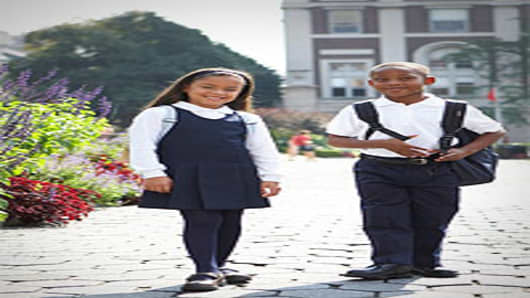Back-to-school fashion is getting a makeover as more school districts adopt uniform dress codes.
French Toast, a company that has manufactured and sold school uniforms since the 1950s, expects to see a 7 percent increase in the number of schools adopting a dress code for the fall.
The company carefully monitors this statistic, and has been seeing a steady increase of schools with dress codes in recent years, according to Michael Arking, president of French Toast.com.
Fueled by this momentum, Arking expects industry-wide uniform sales will rise between 3 and 5 percent this year from last year.
There is plenty of competition in the market, with retailers including Land's End, Kohl's , Target , JC Penney
and the Gap's Old Navy advertising their uniform clothing. (In some cases, French Toast sells its products through retailers such as Burlington Coat Factory and Kmart.)
More schools have been shifting to uniform dress code policies in the wake of studies that have shown uniforms can help reduce school discipline problems, foster a sense of community, and eliminate distractions.
In high-crime areas, uniforms are also said to reduce pressure from gangs, make it less likely that a child will be a victim of theft, and make it easier to identify students of the school.
"They'd rather have students concentrating on what they are learning rather than what they are wearing," said Adam Weil, the director of School Uniforms for Land's End.
But others are critical of uniforms—particularly at public schools—saying uniforms stifle a child's freedom of expression and add to a parent's expense. Some argue uniforms aren't a good solution to school violence and can actually make students a target of bullies from other schools.
Arking disagrees with the cost argument. He said a parent can buy an entire wardrobe at FrenchToast.com for about $120. That calculation is based on a boy having six tops, 4 pairs of pants and one sweater, or a girl having six tops, two pairs of pants, one skort, one pair of shorts, and a sweater.
By comparison, the National Retail Federation is estimating that parents will spend an average of $225.47 on jeans, shirts and other types of clothing during the back-to-school period this year.
The expense can even be less for schools are adopting dress code policies that require a specific color and style of dress be worn, instead of a uniform with a specific logo.
For example, the public school district in Red Bank, N.J., recently adopted a uniform dress code for the upcoming school year. In doing so, the district joined nearby towns such as Asbury Park, Lakewood, and Neptune, which all have some form of uniform dress code in place.
But instead of mandating a specific uniform, Red Bank is requiring students to wear khaki pants or a skirt with a red, white or black polo shirt. The policy also allows students to substitute sweaters or turtlenecks in the appropriate colors during the winter.
Superintendent Laura Morana told local press that the policy was aimed at giving parents more flexibility because with this type of policy, parents can shop for back-to-school at pretty much any store.
The back-to-school season is crucial for companies that sell uniforms. They make about 80 percent of their yearly sales of about $1 billion during the months leading up to the new school year, according to Arking.
Land's End, a unit of Sears Holdings , said given concerns about the economy, they are stressing the value their clothing offers as well as their clothing guarantee when they talk to schools about providing uniforms for them.
Land's End also recently added uniform departments within 209 of its Land's End Shops at Sears stores to better serve their customers.
Not only do the uniform departmentsallow students to try on clothing before buying, but if the order is placed in the store, parents receive free shipping on the clothing they are purchasing.
Many of the retailers, including Land's End, also offer schools cash back on purchases the students make. Schools can use this money to fund activities or other programs.
While some uniforms still have traditional elements such as logos or insignias, most uniforms are vastly different than those wore decades ago. Many tend to be a little less formal and they have a bit more styling. For example, skinny pants and tapered blouses and polos for girls, Arking said.
Neither Weil nor Arking expect the trend to slow down soon. Part of the reason is the continued explosion of charter schools, which tend to favor uniform dress codes, as well as the shift toward uniforms for younger age groups, including toddlers at daycare centers.
"Parents want to get away from the label-consciousness," Arking said.
Questions? Comments? Email us at consumernation@cnbc.com




